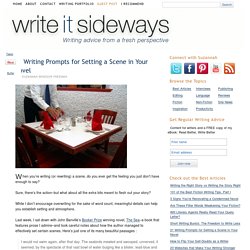

Al's Writing Block: Writing: How to Describe a Room. I've noticed lately in the stats that people have been actively searching for "how to describe a room.

" Even though I had done a writing prompt that called for using the description of a room, I never did go over the particulars of describing locations. So for anybody looking for some specific answers, here are my thoughts on describing interior settings, for fiction and prose. First and foremost, you got to ask yourself, what importance is the room or setting to the story or characters? If the room is only there for a brief passing scene, it may just suffice to say "so-and-so went into the broom closet. It was dark, cramped, and loaded with brooms. " For more significant settings, where you really do want to paint the picture in the readers' heads and firmly establish a sense of space or ambiance, then of course you'll want to dig into more details.
The objects in a room - furniture and stuff - may or may not factor into your scene. American English Dialects. David Morrell On the Key to Settings. In his CraftFest session at ThrillerFest, “Setting: How to Make Your Novel Go Places,” David Morrell (author of First Blood) riffed on how to produce fantastic settings that become characters in their own right.

Morrell pointed out that settings are seldom talked about, and often receive short shrift in comparison to other craft elements. But they shouldn’t. Think of Hemingway. What immediately comes to mind is Key West; Havana; Paris—“Places he wrote about, and when he wrote about them, seemed to own them.” Consider Faulkner’s deep South. So what’s the key to crafting distinct, rich, truly alive settings in your work? “What we need to do is forget about sight, and concentrate on feeling,” Morrell said. Hemingway would describe a scene so you would feel it as if you were really there. Morrell cited novelist John Barth’s method of “triangulation”—you take the sense of sight for granted, and add two other senses from among the remaining four.
5 Ways to Take Your Readers Back in Time: The Importance of Historical ResearchWritersDigest.com. There is nothing that jolts a reader out of a sense of place and time more effectively than using a modern voice for a Victorian heroine, no matter how richly detailed the description of her gorgeous crinoline and pantalets.

“I need my own space,” certainly informs the reader that your heroine is upset, so upset she must be alone. But any young woman from the 1800s was more likely to murmur: “I have some letters to write.” And before her startled beau has a chance to respond, has left the room back rigid with outrage. Authenticity enhances atmosphere and keeps the reader in the world you have created for them. Otherwise you are writing a costume drama set in 21st century America.
GIVEAWAY: Tessa is excited to give away a free copy of her novel to a random commenter. 21 Writing Prompts for Setting a Scene in Your Novel. When you’re writing (or rewriting) a scene, do you ever get the feeling you just don’t have enough to say?

Sure, there’s the action–but what about all the extra bits meant to flesh out your story? While I don’t encourage overwriting for the sake of word count, meaningful details can help you establish setting and atmosphere. Last week, I sat down with John Banville’s Booker Prize winning novel, The Sea–a book that features prose I admire–and took careful notes about how the author managed to effectively set certain scenes. Here’s just one of its many beautiful passages : I would not swim again, after that day. From this passage, I know the narrator is remembering something unpleasant from his past, and the imagery foreshadows what happens later in the story. Based on my reading, the following are 21 writing prompts for creating depth in your prose: Where does the scene take place? 10 Questions to Ask When You Create a Fictional Culture. The way I build worlds is by collecting cool stuff from the history, myth and people around me.

I blend these details with my own imagination, and create my own cultures. Culture is a vital part to realistic worldbuilding. Normally there are a few particular cultures that interest me at a given time. I read whatever I can find about them, their environment, their traditions and their myths. The interesting details filter into the new world I’m creating (example: at one time, Venetian widows could only remarry on the stroke of midnight). In the long term, there is nothing more inspiring and challenging than visiting foreign cultures yourself (especially if you can get far beyond your comfort zone to do it). But reading (non-fiction, myth/legend/fairytales, as well as the classics like Dune and Lord of the Rings) and watching documentaries/films can get you a long way toward filling up on your inspiration tank. History's Most Over-the-Top Sunset Descriptions. "Sunset Over the Golden Horn," by Ivan Constantinovich Aivazovsky, from 1866.
